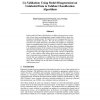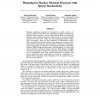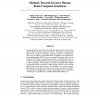NIPS
2004
14 years 28 days ago
2004
Most existing tracking algorithms construct a representation of a target object prior to the tracking task starts, and utilize invariant features to handle appearance variation of...
NIPS
2004
14 years 28 days ago
2004
In the context of binary classification, we define disagreement as a measure of how often two independently-trained models differ in their classification of unlabeled data. We exp...
NIPS
2004
14 years 28 days ago
2004
NIPS
2004
14 years 28 days ago
2004
We propose a new method for estimating intrinsic dimension of a dataset derived by applying the principle of maximum likelihood to the distances between close neighbors. We derive...
NIPS
2004
14 years 28 days ago
2004
Areas of the brain involved in various forms of memory exhibit patterns of neural activity quite unlike those in canonical computational models. We show how to use well-founded Ba...
NIPS
2004
14 years 28 days ago
2004
The correction of bias in magnetic resonance images is an important problem in medical image processing. Most previous approaches have used a maximum likelihood method to increase...
NIPS
2004
14 years 28 days ago
2004
We present a probabilistic approach to learning a Gaussian Process classifier in the presence of unlabeled data. Our approach involves a "null category noise model" (NCN...
NIPS
2004
14 years 28 days ago
2004
We present a graphical model for beat tracking in recorded music. Using a probabilistic graphical model allows us to incorporate local information and global smoothness constraint...
NIPS
2004
14 years 28 days ago
2004
During the last ten years there has been growing interest in the development of Brain Computer Interfaces (BCIs). The field has mainly been driven by the needs of completely paral...
NIPS
2004
14 years 28 days ago
2004
This paper presents an application of Boosting for classifying labeled graphs, general structures for modeling a number of real-world data, such as chemical compounds, natural lan...



